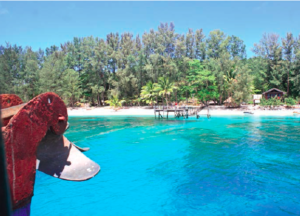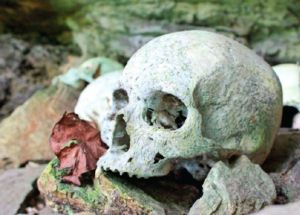From big sea creatures to ancient skulls, Christina Larmer discovers there’s more to the Papua New Guinean Doini Island Plantation Resort than lolling by the beach.
“They say the Milne Bay is one of the safest regions in the country, sheltered by the impenetrable Owen Stanley Ranges, and you certainly feel cocooned here, with the softly spoken staff shepherding you everywhere.”
I know I should be nervous as a giant manta ray glides beneath our tiny dinghy, its enormous width magnified in the shadowy blue ocean below, but all I can think is, “must get the snorkelling gear on pronto and take a closer look”.
 Before I can manage to tug my flippers on, however, the magnificent creature has vanished, off to the tip of a nearby island, where it will join the queue of other manta rays waiting to be groomed by a diligent team of reef-dwelling ‘cleaner fish’.
Before I can manage to tug my flippers on, however, the magnificent creature has vanished, off to the tip of a nearby island, where it will join the queue of other manta rays waiting to be groomed by a diligent team of reef-dwelling ‘cleaner fish’.
Like an underwater car wash, this manta ray cleaning station is one of the most extraordinary marine spectacles in the world and just one of numerous drawcards of neighbouring Doini Island, where my dinghy full of dim-dims (a nickname for white people) has been staying.
Shaped a little like a manta ray itself, Doini Island is in the heart of the Milne Bay, on Papua New Guinea’s eastern tip. Over the decades, this 1100-hectare private island has undergone several transformations, from local burial site (more on that later) to coconut plantation, where I spent time as a child. Back then, it had little more than a thatched guesthouse for stragglers, a kerosene fridge for supplies, and nowhere to dock your boat.
 Today it’s blossomed into the Doini Island Plantation Resort, a beautifully crafted eco-resort, complete with two jetties. Getting there is still an adventure, though, requiring a quick flight with Air Niugini from Port Moresby to the provincial capital, Alotau, and then a bumpy boat ride. The latter can take between one-and-a-half and four hours, depending on the vessel, so bring a book, some sunscreen, and your camera for the pod of cheeky dolphins that gleefully escort you through the harbour.
Today it’s blossomed into the Doini Island Plantation Resort, a beautifully crafted eco-resort, complete with two jetties. Getting there is still an adventure, though, requiring a quick flight with Air Niugini from Port Moresby to the provincial capital, Alotau, and then a bumpy boat ride. The latter can take between one-and-a-half and four hours, depending on the vessel, so bring a book, some sunscreen, and your camera for the pod of cheeky dolphins that gleefully escort you through the harbour.
Once on the island, everything is a breeze. There’s a range of accommodation to suit a variety of needs and budgets, including beachside bungalows with ensuites for up to six guests, a larger executive bungalow with its own jetty, and a revamped guesthouse set back from the beach beneath a shady poinciana, with cooking facilities and bedding for 12.
There’s a bar and restaurant offering three meals daily, including room service and three-course dinners inspired by the local ingredients — think fresh fish with Asian greens and cooked bananas in caramel sauce.
The dining area is the heart of the resort and a visual feast. Designed around eight, hand-carved kasikasi poles, it features four bright murals painted by local artists and reflecting the country’s distinctive cultures, from the Highlands to the Milne Bay’s ancient trade network, the Kula Ring . Who needs a local guide book when you can just look up from your continental breakfast?
Large decks extend from the restaurant, reaching out over the sand and to one jetty that is so impressive that it’s P&O approved. In fact, Doini Island plays host to various cruise ships throughout the year. But don’t panic; for the most part you’ll have the island all to yourself, if you don’t count the resident crocodile and the ghosts of elders past, that is; because the other big drawcard is the legendary skull cave.
Hidden like buried treasure in the thick rainforest, the cave is an eerie reminder that you can modernise the facilities, but Doini Island’s cultural history lingers. Really just a rocky ledge that shelters the skulls of 20-plus clansmen, the skull cave has always been the island’s pièce de résistance, the thing that draws me back time and again.
 Today the track is more tourist friendly than I recall, but it’s still a sweaty hour’s walk from the main resort, and just as foreboding when you scramble up the final leg and encounter the skulls, some missing their jawbones, others with teeth clinging like dried kernels of corn. Local legend has it they’re the remains of esteemed villagers whose bodies were buried in an upright position after death, their heads poking out above the ground. A clay pot was placed over them until they snapped free, then the skulls were carried to this reclusive burial spot, shepherded by the remaining clan.
Today the track is more tourist friendly than I recall, but it’s still a sweaty hour’s walk from the main resort, and just as foreboding when you scramble up the final leg and encounter the skulls, some missing their jawbones, others with teeth clinging like dried kernels of corn. Local legend has it they’re the remains of esteemed villagers whose bodies were buried in an upright position after death, their heads poking out above the ground. A clay pot was placed over them until they snapped free, then the skulls were carried to this reclusive burial spot, shepherded by the remaining clan.
They say the Milne Bay is one of the safest regions in the country, sheltered by the impenetrable Owen Stanley Ranges, and you certainly feel cocooned here, with the softly spoken staff shepherding you everywhere. Like the popular Ghost Who Walks , you never really notice they’re there until you veer off course and a gentle nod prods you back on track, or your legs grow weary and a tractor-trailer appears to whisk you away.
It’s also an efficiently run operation with everything in easy reach and most of your needs covered. There’s a laundry service, tropical-strength insect spray in every room, a small shop with souvenirs, gifts and toiletries, spare snorkelling gear and kayaks, and various vessels for hire.
We take advantage of this one day and head to neighbouring Samarai, once the thriving provincial headquarters and now a shell of its former self.
Situated about 10 kilometres northwest of Doini Island, it’s worth a visit, especially if you’re an enthusiast of World War 2, when the town was destroyed and then rebuilt.
Gem seekers can also clinch a bargain from the resident Pearl Man, who sells his locally produced wares at the now dilapidated main wharf. Nearby Kwato Island is also worth a stop, if only to explore the ageing stone church, which was built by early London missionaries.
We take a moment to enjoy a family game of cricket on the parched field in front of the wharf, before heading back to Doini Island where you can commandeer a dinghy to go fishing, diving or circumnavigating the island.
 Or, like us, simply stay anchored for the rest of the day, exploring the surrounding coral reef. Conveniently located within wading distance of your beach bungalow, you just pop on your goggles and go. My children are enthralled by a family of clownfish who re-enact Finding Nemo each time we float past; ‘Marlin’ and ‘Nemo’ popping out tentatively from the anemone before zipping back in again.
Or, like us, simply stay anchored for the rest of the day, exploring the surrounding coral reef. Conveniently located within wading distance of your beach bungalow, you just pop on your goggles and go. My children are enthralled by a family of clownfish who re-enact Finding Nemo each time we float past; ‘Marlin’ and ‘Nemo’ popping out tentatively from the anemone before zipping back in again.
And when you’ve had your fill of sun, sea and celebrity fish, you can trek to Tuyam Point, head to the hilltop look-out, or kick back with a book on the main deck. There, you’ll find sofas strategically positioned to soak up the ocean view while you lap up the freshly baked muffins that are available with tea and coffee facilities all day. I have to confess, I found myself lounging there on more than one occasion. After all, there are only so many giant sea creatures and ghoulish skulls one dim-dim can handle in one holiday.
Paradise Magazine, March/April 2016

